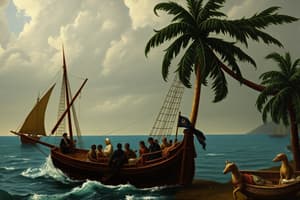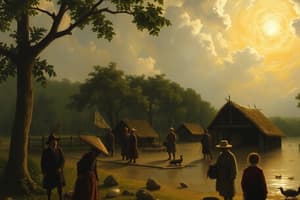Podcast
Questions and Answers
What was the primary goal of Christopher Columbus's voyage in 1492?
What was the primary goal of Christopher Columbus's voyage in 1492?
- To spread Christianity to the indigenous people
- To explore the New World and settle new colonies
- To trade goods with the Native Americans
- To find a faster and easier way to reach Asia (correct)
What was the name of the author who coined the phrase 'Columbian Exchange'?
What was the name of the author who coined the phrase 'Columbian Exchange'?
- Ferdinand Magellan
- Alfred Crosby (correct)
- Christopher Columbus
- Vasco da Gama
Which of the following items was NOT introduced to Europe from the New World?
Which of the following items was NOT introduced to Europe from the New World?
- Coffee
- Chocolate
- Tobacco
- Sugarcane (correct)
What was the devastating consequence of the Columbian Exchange for the Native Americans?
What was the devastating consequence of the Columbian Exchange for the Native Americans?
Which of the following animals was introduced to the New World from the Old World?
Which of the following animals was introduced to the New World from the Old World?
What was the name of the event that led to the transfer of plants, fruits, vegetables, disease, and other items between the Old World and the New World?
What was the name of the event that led to the transfer of plants, fruits, vegetables, disease, and other items between the Old World and the New World?
Which of the following diseases was brought from the Old World to the New World?
Which of the following diseases was brought from the Old World to the New World?
What was the result of the natives in the Americas not having immunity to smallpox?
What was the result of the natives in the Americas not having immunity to smallpox?
What was the outcome when Christopher Columbus encountered the Taino people?
What was the outcome when Christopher Columbus encountered the Taino people?
What prompted the rise of race-based slavery during the Columbian Exchange?
What prompted the rise of race-based slavery during the Columbian Exchange?
What was the primary goal of European countries during the Columbian Exchange?
What was the primary goal of European countries during the Columbian Exchange?
What was the main route that European traders took to transport enslaved people?
What was the main route that European traders took to transport enslaved people?
What was one of the most significant outcomes of the Columbian Exchange?
What was one of the most significant outcomes of the Columbian Exchange?
What crops were introduced to the New World from the Old World?
What crops were introduced to the New World from the Old World?
What is an example of how the Columbian Exchange still affects America today?
What is an example of how the Columbian Exchange still affects America today?
Flashcards are hidden until you start studying
Study Notes
The Columbian Exchange
- The Columbian Exchange was the exchange of plants, fruits, vegetables, disease, and other items between the Old World (Europe, Asia, and Africa) and the New World (The Americas) after Christopher Columbus' explorations in 1492.
Christopher Columbus and the Age of Exploration
- Christopher Columbus was a sailor and explorer who searched for a faster and easier way to reach Asia, but discovered new foods and resources in the New World.
- He introduced items like peppers, tobacco, and chocolate to Europe and brought horses, cattle, and pigs to the New World in 1493.
Items Traded During the Columbian Exchange
- Goods traded from the New World to the Old World: maize, peanuts, pineapple, potatoes, tomatoes, habanero peppers, turkeys, llamas, tobacco
- Goods traded from the Old World to the New World: sugarcane, coffee, horses, pigs, sheep, chickens
Disease During the Columbian Exchange
- Diseases spread rapidly, killing many Natives in the New World, with 90% of the native population destroyed by diseases.
- Smallpox was brought from the Old World to the New World, and natives had no immunity, leading to many deaths.
- Syphilis originated in the Americas and was brought to the Old World by explorers.
Slavery During the Columbian Exchange
- Christopher Columbus enslaved the Taino people, and other explorers followed, forcing Natives to convert to Christianity and enslaving them.
- The Columbian Exchange led to a race-based system of slavery, where humans were viewed as property.
Economic Impact of the Columbian Exchange
- The Columbian Exchange led to the establishment of the Transatlantic Trade Route, also known as Triangular Trade.
- Europe was the main player in this trading route, with goods and enslaved people being traded between West Africa, the Caribbean, and English Colonies.
Importance of the Columbian Exchange
- The Columbian Exchange increased food production around the world, with Old World crops thriving in the New World.
- Sugar cane, wheat, barley, and rice were introduced to the New World and became staples.
Pros and Cons of the Columbian Exchange
- Pros: introduction of new foods, increased nutritional value, and agricultural revolution.
- Cons: disease, introduction of slavery, and institution of chattel slavery.
Studying That Suits You
Use AI to generate personalized quizzes and flashcards to suit your learning preferences.




